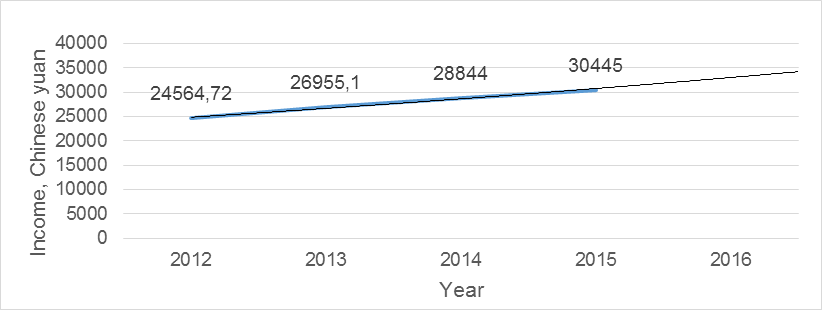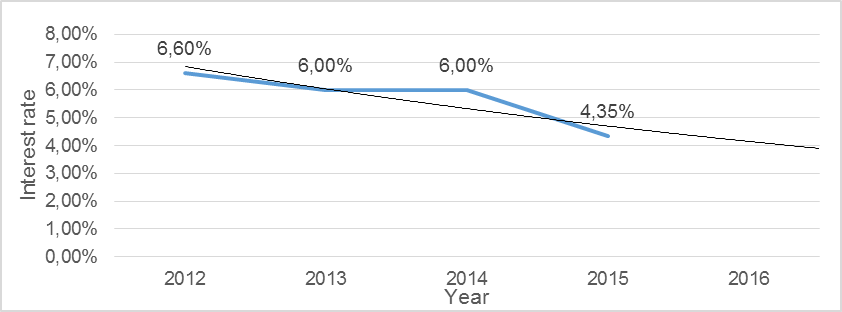The conditions for the Walt Disney Parks and Resorts Worldwide, Inc. functioning in China are quite favorable. During the last years, the positive changes of the key macroeconomic indicators in China have created conditions for the rapid development of the travel and leisure industry. Combined with the elaborate and effective marketing and sales policies, this leads to the company’s overall successful performance and drives to the suggestion that the trends in 2016 will be even more positive.
Among the macroeconomic indicators defined as those which influence the tourism and leisure sector, the most are personal disposable income, inflation rate, and investment interest rate. Building a trend line based on the previous data that covered the period from 2012 till 2014, one will see that disposable income per capita is expected to rise in 2016 while inflation and interest rate tend to decrease (Trading Economics, n.d.).



As was revealed previously, the Walt Disney Parks and Resorts financial performance during the 2012-2014 period demonstrated positive dynamics. Analyzing the financial indicators of the last quarter of 2015, one can see that the Parks and Resorts revenue increased by 7% and was 16,16 billion dollars in comparison to the last year’s 15,09 billion (The Walt Disney, 2015, p. 2).
The Shanghai Disney Resort is expected to open in spring 2016; it will include most up-to-date, innovative entertainment facilities developed especially for the Chinese audience (Disney unveils new magic in Shanghai, n.d.).
The Chinese tourist industry currently is experiencing a period of rapid growth. In the previous decade, the government economic policies focused on industrial development leading to the annual GDP growth up to 15% before the financial crisis of 2008 and over 12% in 2010.
The recent structure of the GPD is gradually shifting from industry to services. This causes a slower but more sustainable growth of the GDP. The governmental policies are now concentrated on curbing excessive credit growth and further stimulation of foreign investment, as now the consumption rate grows faster than investment (The World Bank, 2015).
Up to 2022, “the number of upper-middle-class and affluent households in China is expected to grow 18 percent annually” (Shanghai Disney Resort accelerates resort expansion, 2014, para. 4). As the middle and upper-middle class representatives are the main consumers of the travel and entertainment services, this makes China an extremely attractive destination for private capital investment.
The China National Tourism Administration declared the next two decades “a golden period for Chinese tourism development” (Wen, 2015, para. 4), and this industry has all chances to become one of the main drivers of further GDP growth. The projected revenue from tourism and leisure in 2015 is over 160 billion dollars (Wen, 2015).
Overall, it can be seen that in 2016 and the following years, the Walt Disney Parks and Resorts Worldwide can become the major player in the Chinese travel, leisure, and entertainment market. Despite being a communist state, China has successfully moved from the command-administrative economic system and became the world market leader in production; and now it aims to be the leader in services as well.
Apart from continuing to receive revenues from the park in Hong Kong and upon finishing the construction of the Disney Resort in Shanghai, Walt Disney may search for more perspective places in China to establish its services.
References
Disney unveils new magic in Shanghai. (n.d.). Web.
Shanghai Disney Resort accelerates resort expansion. (2014). Web.
The Walt Disney. (2015). The Walt Disney Company reports fourth quarter and full year earnings for fiscal 2015. Web.
The World Bank. (2015). China economic update. Web.
Trading Economics. (n.d.) China | Economic indicators. Web.
Wen, W. (2015). Tourism companies see sunny days ahead. Web.